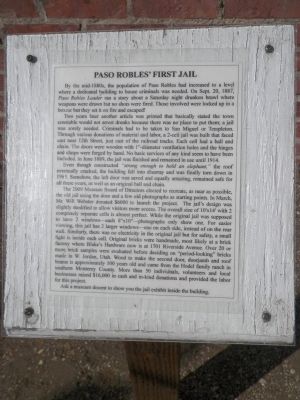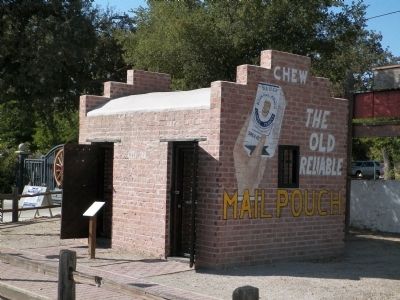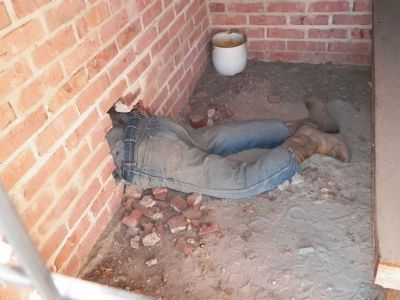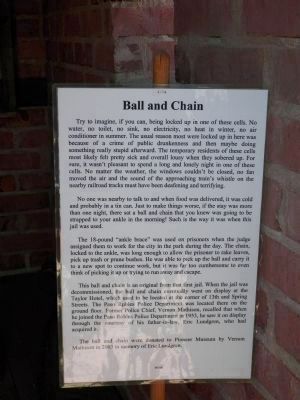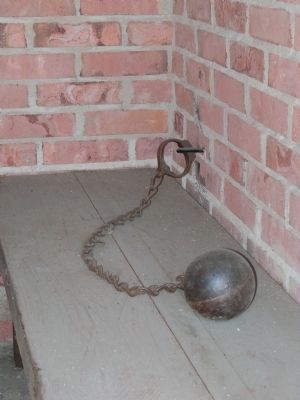Paso Robles in San Luis Obispo County, California — The American West (Pacific Coastal)
Paso Robles’ First Jail
Two years later another article was printed that basically stated the town constable would not arrest drunks because there was no place to put them; a jail was sorely needed. Criminals had to be taken to San Miguel or Templeton. Through various donations of material and labor, a 2-cell jail was built that faced east near 12th Street, just east of the railroad tracks. Each cell had a ball and chain. The doors were wooden with one-inch diameter ventilation holes and the hinges and clasps were forged by hand. No basic services of any kind seem to have been included. In June 1889, the jail was finished and remained in use until 1914.
Even though constructed “strong enough to hold an elephant, ” the roof eventually cracked, the building fell into disarray and was finally torn down in 1965. Somehow, the left door was saved and equally amazing, remained safe for all these years, as well as an original ball and chain.
The 2009 Museum Board of Directors elected to recreate, as near as possible, the old jail using the door and a few old photographs as starting points. In March, Mr. Will Webster donated $6000 to launch the project. The jail’s design was slightly modified to allow visitors more access. The overall size of 10’x14’ with completely separate cells is almost perfect. While the original jail was supposed to have 2 windows - each 8”x10” - photographs only show one. For easier viewing, this jail has 2 larger windows - one on each side, instead of on the rear wall. Similarly, there was no electricity in the original jail but for safety, a small light is inside each cell. Original bricks were handmade, most likely at a brick factory where Blake’s Hardware is now, at 1701 Riverside Avenue. Over 20 or more brick samples were evaluated before deciding on “period-looking” bricks made in W. Jordan, Utah. Wood to make the second door, doorjamb and roof beams is approximately 100 years old and came from the Hodel family ranch in southern Monterey County. More than 50 individuals, volunteers and local businesses raised $16,000 in cash and in-kind donations and provided the labor for this project.
Ask a museum docent to show you the jail exhibit inside the building.
Erected by Paso Robles Pioneer Museum.
Topics. This historical marker is listed in this topic list: Notable Buildings. A significant historical month for this entry is June 1889.
Location. 35° 38.126′ N, 120° 41.244′ W. Marker is in Paso Robles, California, in San Luis Obispo County. Marker can be reached from Riverside Ave., 0.1 miles south of 21st Street/Gregory Street. The recreated jail is one of the outdoor displays at the Paso Robles Pioneer Museum. It is next to the parking lot and just inside the gate. The marker is on a post in front of the jail. Touch for map. Marker is at or near this postal address: 2010 Riverside Avenue, Paso Robles CA 93446, United States of America. Touch for directions.
Other nearby markers. At least 8 other markers are within walking distance of this marker. In Memory Of (within shouting distance of this marker); Geneseo School (within shouting distance of this marker); The Jeanesville Pump (within shouting distance of this marker); First Mennonite Church (approx. 0.3 miles away); Brewster – Dutra House (approx. 0.4 miles away); Paso Robles Veterans Memorial (approx. 0.6 miles away); Carnegie Library (approx. 0.7 miles away); Ignacy Jan Paderewski (approx. 0.7 miles away). Touch for a list and map of all markers in Paso Robles.
Additional commentary.
1. The Ball and Chain Marker - See Photo #4
Try to imagine, if you can, being locked up in one of these cells. No water, no toilet, no sink, no electricity, no heat in winter, no air conditioner in summer. The usual reason most were locked up in here was because of a crime of public drunkenness and then maybe doing something really stupid afterward. The temporary residents of these cells most likely felt pretty sick and overall lousy when they sobered up. For sure, it wasn’t pleasant to spend a long and lonely night in one of these cells. No matter the weather, the windows couldn’t be closed, no fan moved the air and the sound of the approaching train’s whistle on the nearby railroad tracks must have been deafening and terrifying.
No one was nearby to talk to and when food was delivered, it was cold and probably in a tin can. Just to make things worse, if the stay was more than one night, there sat a ball and chain that you knew was going to be strapped to your ankle in the morning! Such is the way it was when this jail was used.
The 18-pound “ankle brace” was used on prisoners when the judge assigned them to work for the city in the park during the day. The chain locked to the ankle, was long enough to allow the prisoner to rake leaves, pick up trash or prune bushes. He was able to pick up the ball and carry it to a new spot to continue work, but it was far too cumbersome to even think of picking it up or trying to run away and escape.
This ball and chain is an original from
that first jail. When the jail was decommissioned, the ball and chain eventually went on display at the Taylor Hotel, which used to be located at the corner of 13th and Spring Streets. The Paso Robles Police Department was located there on the ground floor. Former Police Chief, Vernon Mathison, recalled that when he joined the Paso Robles Police Department in 1953, he saw it on display through the courtesy of his father-in-law, Eric Lundgren, who had acquired it.
The ball and chain were donated to the Pioneer Museum by Vernon Mathison in 2003 in memory of Eric Lundgren.
— Submitted April 8, 2014.
Credits. This page was last revised on June 16, 2016. It was originally submitted on March 27, 2014, by James King of San Miguel, California. This page has been viewed 671 times since then and 33 times this year. Photos: 1, 2, 3, 4. submitted on March 27, 2014, by James King of San Miguel, California. 5. submitted on March 30, 2014, by James King of San Miguel, California. • Syd Whittle was the editor who published this page.
